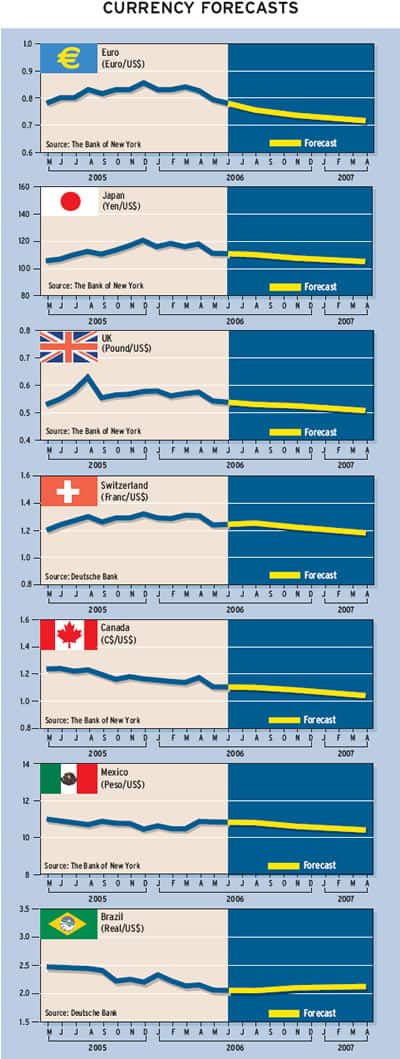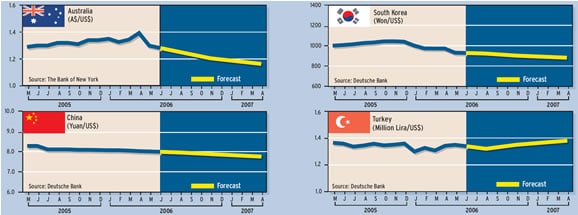The dodge that China has not met the technical definition of manipulation will not satisfy Congress or the American people, said Senator Charles Schumer, the New York Democrat who is co-sponsoring legislation with Republican Representative Lindsey Graham of South Carolina to slap a 27.5% tariff on Chinese imports. US manufacturers contend that China is keeping its currency about 40% undervalued against the dollar to gain a competitive advantage for its exports.
While the Treasury gains a welcome buyer for its bonds when China invests its dollar reserves, it criticized the countrys slow pace of currency reforms. We are not satisfied with the progress made on Chinas exchange-rate regime, and we will monitor closely Chinas progress every step of the way, said Treasury secretary John Snow.
Analysts say this is likely to keep the issue of global imbalances and exchange-rate flexibility clearly in focus and will keep the dollar under downward pressure. The greenback fell sharply last month, hitting an eight-month low against the Japanese yen after the Group of 7 industrialized nations called for countries with trade surpluses to allow their currencies to appreciate more quickly.
In emerging Asia, particularly China, greater flexibility in exchange rates is critical to allow necessary appreciations, as is strengthening in domestic demand, lessening reliance on export-led growth strategies and action to strengthen financial sectors, the G7 finance ministers and central bank governors said in a statement after meeting in Washington on April 21.
Pressure on China to revalue the yuan will be met with a response of more gradualism, says Kenneth DeWoskin, senior consultant in China strategy and business development at PricewaterhouseCoopers. China severed the yuans peg to the dollar last July and revalued its currency by 2.1%. It allows the yuan to move up or down by as much as 0.3% in a day. China is not about to revalue by a large amount because it believes that such a move would be dangerous and could disrupt its economy, he says.
Chinas growth is more a result of price increases than productivity gains, DeWoskin says. The country has maintained its double-digit growth by investing in massive infrastructure projects, but consumption has not developed, he explains. China has excess capacity in steel, pharmaceuticals and other industries, and economic growth cannot continue without sustained inflation, he adds.
Peoples Bank of China governor Zhou Xiaochuan said in a retort a day after the G7 meeting that developed countries also need to do their part to remedy global imbalances by improving the competitiveness of their own exports. He also criticized an agreement by the International Monetary Fund to take a more active role in scrutinizing the foreign exchange policies of its members. Each country is entitled to choose an exchange-rate system consistent with its own economic development, he said.
China surprised market participants on April 27 by raising interest rates for the first time in 18 months. The central bank raised its one-year lending rate by 27 basis points to 5.85% but kept its deposit rate unchanged at 2.25%. The increase was designed to curb loan growth and soak up excess liquidity in the economy.
Unfortunately, because of Chinas primitive financial system, interest rates are a blunt tool, says Diana Choyleva, director and head of the UK service at Lombard Street Research. Chinas economy is headed for a significant cyclical slowdown, she predicts. Over-investment has ruined private-sector profitability, with our estimates suggesting that net return on assets was negative at the end of 2005, she says. Moreover, a likely significant US consumer-led slowdown later in 2006 will hurt demand and profits, revealing the lack of underlying profitability and causing a sharp slowdown, even without the help of the Chinese authorities mistimed tightening, she adds.
When the going gets tough, Chinas current efforts to re-balance growth toward consumer spending will quickly be dropped in favor of muscle-bound development through state-sector firms and projects, according to Choyleva.
The motivation for pushing China to revalue more rapidly is political and is aimed at heading off protectionist trends in the US Congress and, probably in the not-too-distant future, the European Parliament, says David Gilmore, economist and partner at FX Analytics, based in Essex, Connecticut. And then there is the central bankers concern that Chinas currency policy is contributing to a global distortion in credit markets, he says. All those treasuries purchased just to keep the yuan from rising too fast make for lower-than-otherwise US rates that, in turn, imprint yield structure everywhere else.
Chinas trade surplus with the US rose above $200 billion in 2005, but the yuan has failed to rise significantly because China has bought hundreds of billions in dollar-denominated assets. The countrys foreign exchange reserves passed $875 billion at the end of March, an increase of 33% from a year earlier.
And if China stopped buying dollars by letting the yuan float, it would be a disaster for the US treasury market and global interest rates, Gilmore says. Meanwhile, Japan has gladly stayed out of the currency limelight, but with its economy revitalized and deflation conquered, it is time for Japan to shoulder some of the adjustment process, he says. And if Asian currencies rise, Europe might be more willing to tolerate a higher euro versus the dollar.
Currency adjustments alone will not bring the US deficit back to balance, Gilmore says. Ultimately, that will require a higher US savings rate and a lower foreign savings rate, he says. But to ignore the shock-absorbing function of flexible exchange rates in the adjustment process simply elevates the risk of a disorderly adjustment later.


Gordon Platt



